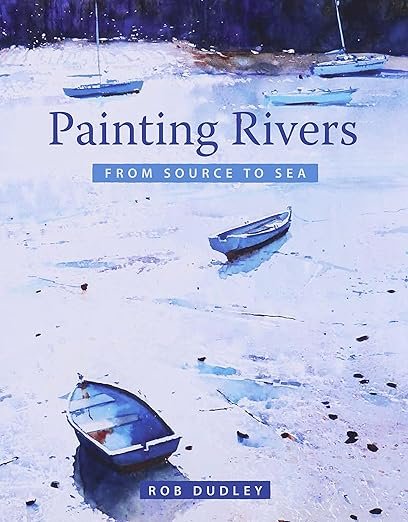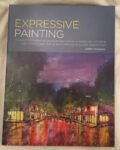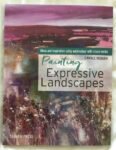My birthday's coming up and I have loads of new art instruction books to look…

Painting Rivers From Source To Sea, Rob Dudley – Book Review
This was the first birthday present book to arrive, so it was the first one that I got my teeth into. It’s written by Rob Dudley who cowrote that book on painting trees that I was really impressed by. Can he do the same with a book about painting rivers?
First things first. It’s a 160 page paperback, published by Crowood, so has nice glossy pages and so much text that you couldn’t finish it in a single sitting. There are about twenty pages at the beginning about gear but after that Rob racks up the content levels and doesn’t let off. We have a chapter on planning and composition and one on the colour of water, then lots of chapters devoted to different parts of the river (from source to sea) but, really, after that chapter in composition, the book settles into a groove that makes everything else feel like a single chapter.
Because what we have is one long story about the river. And it’s a bit like Game Of Thrones switching between viewpoints, except that we’re switching between (i) Rob’s passionate stories about the river and about what he wants to paint, (ii) fourteen painting demonstrations, (iii) discussion of a number of other paintings.
And this big long story has lots of tips within it. Some explicitly spelled out but others where you pick up ideas from Rob’s paintings, seeing things that he did right but that he doesn’t mention. While a lot of these tips are specific to rivers, it felt as if a lot of them would apply to any landscape. I think most of the new ideas I come away with were either around composition or about how exactly Rob spatters his trees and foregrounds. But there are plenty more learning points in there.
The demos themselves should keep the knitting pattern brigade happy. By the knitting pattern brigade I mean those who lern most by religiously copying the author’s work rather than by watching and picking up ideas. They’re worded as instructions rather than as demos, which always bugs me but that’s not a big deal. I’m not a big fan of Rob’s colours (May green in particular) but there’s stuff he does with permanent rose that’s beautiful and that I will be trying to imitate with quinacridone magenta.
What else do I normally talk about? Passion and readability. Rob’s passion comes through in spades. I wouldn’t describe it as a book that I couldn’t put down though: the structure from page 40 onwards, flitting between the story of the river, the demos and the discussions, although brilliantly written, does get a bit samey after a while.
Still, it’s a very good book that gave me plenty of ideas that I want to try out. I feel cruel just saying this but it feels like a step down from the book in trees for two reasons: (i) this wasn’t as focused on rivers as the trees book was focused on trees: it was more like a book on landscapes illustrated with examples of paintings of rivers, (ii) it felt like a flat journey from about page 40 onwards with no hills or corners: at least with the tree book we’d be switching between authors. But apart from that, most of my comments are the same as those I made about the book on trees.
This one feels on the cusp of 3 or 4 palettes. On the one hand, it doesn’t feel like a two palette difference between the two books. On the other hand, it feels to me like these books deserve eight palettes on aggregate rather than nine. What to go for? Look, I’m going to pretend I’d never read the book on trees. What would I give this book if that were the case? I think I’d go for three palettes (a good score, let me remind you), fearing that a four palette rating would be a prime candidate for culling were palette inflation needing to be addressed at some point. Yeah, three palettes, good book, worth the money, four stars on Amazon.
🎨🎨🎨
You can find this book and more reviews of it at Amazon UK here. As an Amazon Associate, I earn commission from qualifying purchases but this costs absolutely nothing extra to you.








Leave a Reply